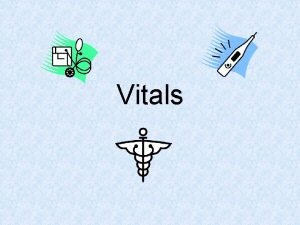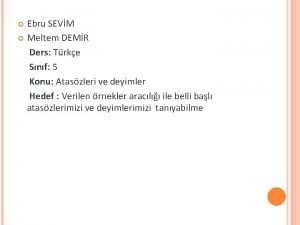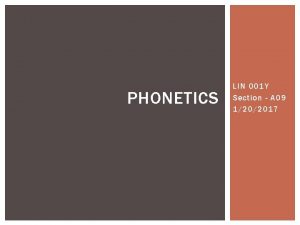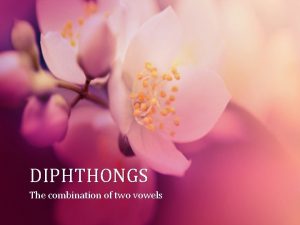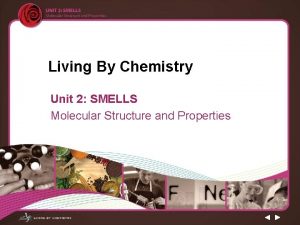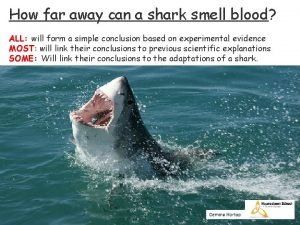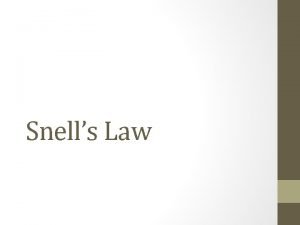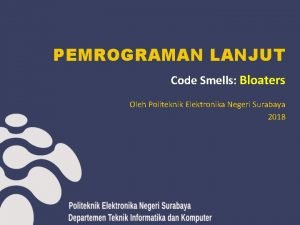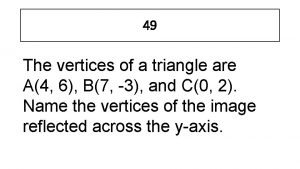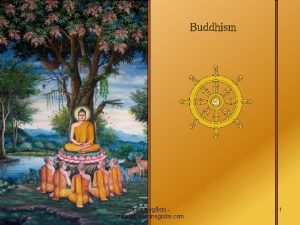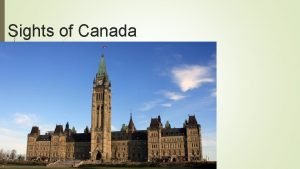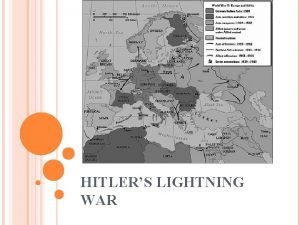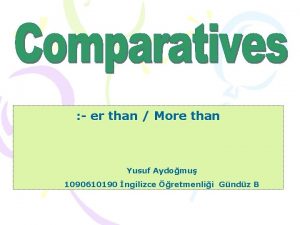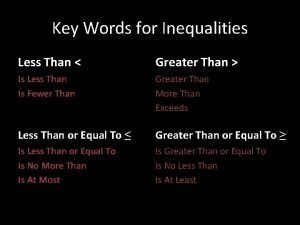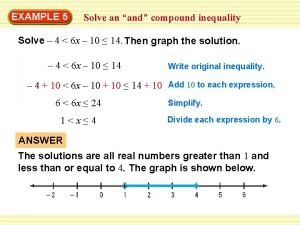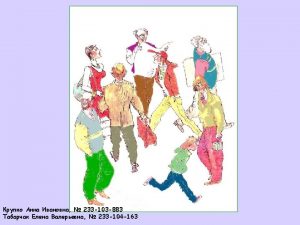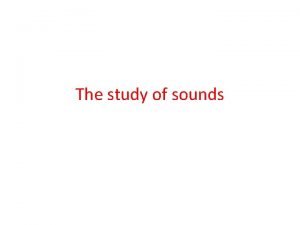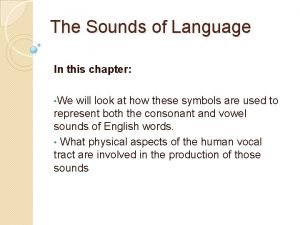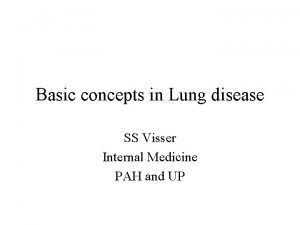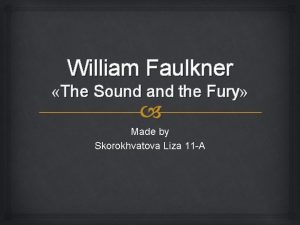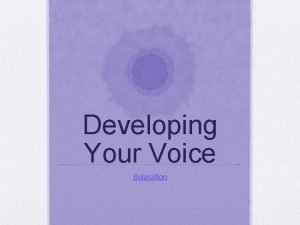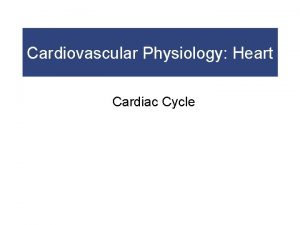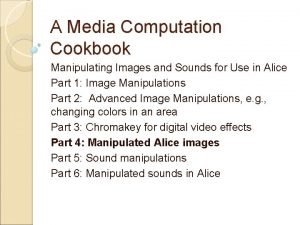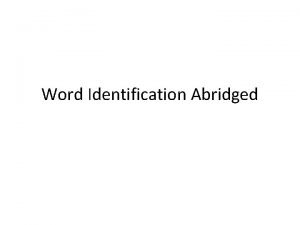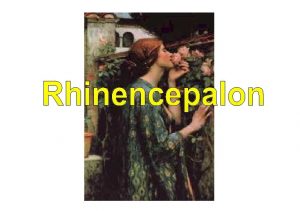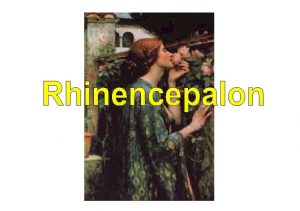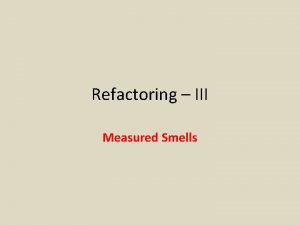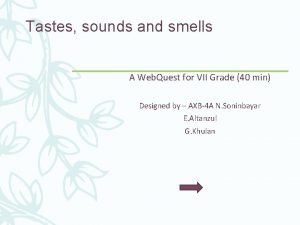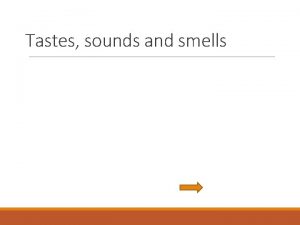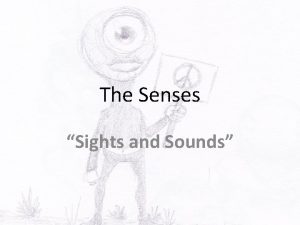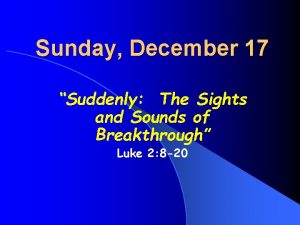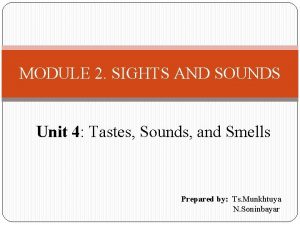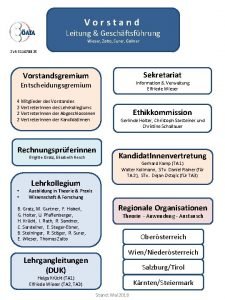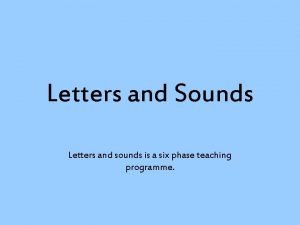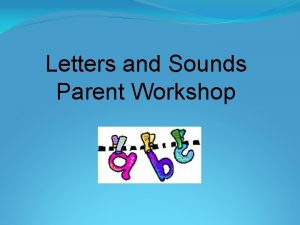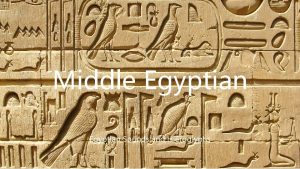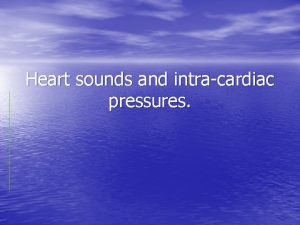Smells are surer than sounds and sights to






















































- Slides: 54


Smells are surer than sounds and sights to make your heart-strings crack. Rudyard Kipling

Olfactory system n Conveys specific visceral sensation (smell) via n. olfactorius. n Does not relay in the thalamus. n Connections with thalamus, hypothalamus, amygdaloid complex & hippocampal formation.

Structure of the olfactory system Receptor cells n Chemoreceptors. n Aboutо 25 billions on each side. n Located in the nasal mucosa. n Regenerate. n 1 st order neurons in the olfactory pathway. n Bipolar neurons, unmyelynated axons form nn. оlfactоrii. n In bulbus olfactorius the axons synapse with the mitral cells in olfactory glomerulus.

Olfactory nerves

Olfactory bulb

Olfactory bulb n n Lies on lamina cribrosa of ethmoid bone Entered by olfactory nerves. 6 -layered structure. 4 cell types: – – n periglomerular - inhibitory tufted - efferent (ІІ order) mitral - efferent (ІІ order) granule - inhibitory Glomerulus – polysynaptic structure, ensuring conversion of olfactory impulses on the mitral cells.

Synaptic organization of the olfactory bulb Dendrodendrite synapses Glutamate (excitory) GABA (inhibitory)

Olfactory Tract: – – in the olfactory sulcus. axons of mitral and tufted cells. anterior olfactory nucleus (modulator): terminates in the olfactory triangle. Stria olfactoria lateralis – to primary olfactory cortex through limen insulae Stria olfactoria medialis – to area subcalosa and gyrus paraterminalis

Tractus olfactorius

Olfactory corex n Primary – – n on the uncus (area 34 after Brodmann). fibers from stria olfactoria lateralis. contains prepiriform & periamygdaloid areas. connectins with nucl. medialis dorsalis of thalamus, hypothalamus, hipocampal formation. Secondary – entorhinal area of gyrus parahippocampalis (area 28). – impulses from primary areas. – efferents to hippocampus. n Orbitofrontal cortex – Impulses from nucl. medialis dorsalis thalami – conscious pereception of smell.

Olfactory corex

Orbitofrontal cortex We need our orbitofrontal cortex to make intelligent choices. Its individual cells code for value. Ann Thomson, Nature Neuroscience

Pathways in the olfactory system

Limbic system

Limbic system n Morphological substrate of emotions and behaviour. n Role in emotional behavior, feeding, defensive reaction, sexual behaviour, memory and learning. n Functions mediated through hypothalamus and autonomic system. n Contains cortical & subcortical (nuclei) structures.

Affective behavior Emotion Happiness and Grief

Introduction Concept Broca (1877) - ‘La Grand Lobe Limbique’ Papez (1937) - ‘Limbic Circuit’ - emotion Mac. Lean (1952) - ‘Limbic System’ – visceral brain Nauta (1972) - ‘Septo-hypothalamo-mesencephalic continuum’

PAUL BROCA (1824 -1880) JAMES PAPEZ (1883 -1958)

Limbic system - Term of Paul Mac. Lean (1952) - Visceral brain -Triple concept of brain evolution Hypothalamus Nucleus accumbens Nucleus amygdaloideus Cortex orbitofrontalis Some psychiatric implications on physiological studies on frontotemporal portions of limbic system (visceral brain). Electroencephalogr Clin Neurophysiol 4: 407 -418, 1952 Paul D. Mac. Lean (1913 - )

Parts of the limbic system Olfactory cortex Septo-(Preoptico)-Hypothalamo- Mesencephalic Continuum Hippocampal formation Area septalis Midbrain Hypothalamus Amygdaloid complex Limbic system Spinal cord & Brain stem

Expression of emotion Septohypothalamomesencephalic continuum

Functions of Limbic System Ancient Role for survival in the animal kingdom. Four basic categories 1. Homeostatic functions including autonomic and neuroendocrine control 2. Olfaction 3. Memory 4. Emotions and drives “HOME”

Other functions of the limbic System • Generates emotions (Emotional brain) • Adds feelings to sensory experience which direct to behavior. – interpret the sensory experience as pleasant or unpleasant. • Memory and learning which is closely linked to emotion. • Sexual behavior, emotions of rage, fear, anxiety and motivation

Lobus Limbicus Gyrus Fornicatus Gyrus Cinguli Gyrus Parahippocampalis Area Entorhinalis Isthmus Hippocampal Formation Hippocampus Proper (Ammon’s horn) Gyrus Dentatus Subiculum Hippocampal Rudiments Gyrus Fasciolaris Indusium Griseum Classification of cortex Isocortex - Neocortex Allocortex Archicortex Hippocampus Gyrus Dentatus Paleocortex Bulbus Olfactorius Lobus Piriformis Mesocortex (Juxtallocortex, Periallocortex, Mesallocortex) Gyrus Cinguli

Parts of the limbic system

Limbic cortex n On medial aspect of the hemispheres n Archicortex – In some parts paleo- & neocortex. n External ring n Internal ring

Limbic cortex External ring - gyrus cinguli - area subcallosa - gyrus parahippocampalis - uncus. Internal ring - gyrus paraterminalis - indusium griseum - Hippocampal formation.


Hippocampal formation Hippocampus (Ammon’s horn, Cornu Ammonis) Gyrus Dentatus Subiculum

Hippocampal formation Hippocampus – cortical fold in the lateral ventricle caused by sulcus hippocampi - 3 -layered archicortex - stratum pyramidale - efferents, forming alveus and fimbria hippocampi - stratum moleculare - stratum radiatum - Subiculum (paleocortex) - affrents from hippocampus - efferents to corpora mamillaria and nucl. anterior thalami Parasubiculum (paleocortex) - transition to gyr. parahippocampalis

Hippocampal formation 1. uncus 2. gyrus dentatus 3. fornix 4. corpus callosum 5. gyrus fasciolaris 6. sulcus hippocampalis 7. gyrus parahippocampal 8. sulcus collateralis

Hippocampal formation (lateral view)

Hippocampal formation - Archicortex - 3 layers Hippocampus Proper Str. Moleculare Str. Pyramidale Str. Polymorphe Gyrus Dentatus Str. Moleculare Str. Granulare Str. Polymorphe Subiculum Transient between hippocampal archicortex and entorhinal paleocortex

Classification of the cortex Isocortex 6 -layered cortex homotypical and heterotypical Allocortex Paleocortex olfactory cortex - lobus piriformis Archicortex 3 -layered - hippocampal formation

Hippocampus and memory

Connection in the hippocampal formation 1. Internal connections trisynaptic pathway 2. Afferent connections perforant and alveolar pathway 3. Efferent connctions fornix

Internal connections Classical 3 -neuron pathway 1. Entorhinal cortex (perforant pathway) granule cell of gyrus dentatus 2. Granules cells (mossy fiber) CA 3 pyramid cells 3. Pyramid cells (Schaffer collateral) CA 1 pyramid cells subiculum cortex entorhinalis

Afferents From Cortex Entorhinalis Alveolar pathway from medial EC to CA 1 and Subiculum Perforant pathway from medial EC to CA 1, CA 2, CA 3 & Gyrus Dentatus

Efferents FORNIX Alveus Fimbriae Crus Commissurа Corpus Column

Efferents Fornix - from pyramid cells of hippocampus & subiculum - 1. 2 million fibers Postcommissiral Fornix – basic bundle to Corpus Mammillare Thalamus Anterior Nuclei Septi Lateralis Hypothalamus Tegmentum of midbrain

Efferents Precommissural Fornix – smaller - mainly from hippocampus to Nuclei Septi Area Preoptica Lateralis Area Hypothalamica Anterior Nucleus Striae Diagonalis Broca Nucleus Accumbens Medial aspect of frontal lobe Nucleus Caudatus & Putamen Amygdala & Claustrum

Summary of connections Afferent Entorhinal Cortex Alveolar pathway medial EC to CA 1 and Subiculum Perforant pathway from lateral EC to CA 1, CA 2, CA 3 and Gyrus. Dentatus Gyrus Dentatuse Mossy fiber - CA 3 - Schaefer fiber (CA 3 -CA 1) Others Hypothalamus, Nuclei Septi, Substantia Innominata Midbrain Efferent FORNIX from pyramid cells hippocampus & subiculum Alveus, Fimbriae, Crus Commissure, Corpus, Column Precommissural Fornix to Nuclei Septal, Nucleus Accumbens Area Hypothalamica Anterior Nucleus Olfactorius Anterior Postcommissural Fornix to Corpus Mammillare Thalamus Anterior Hypothalamus Nucleus Striaе Terminalis

Subcortical limbic structures 1. Amygdaloid complex 2. Mammillary body 3. Septal area 4. Nucleus anterior, nucleus medialis dorsalis & nuclei intralaminares thalami 5. Nucleus accumbems 6. Substantia innominata 7. Nuclei habenulae 8. Hypothalamus 9. Midbrain limbic nuclei

Amygdala L. almond K. F. Burdach’s term

Amygdaloid complex

Amygdaloid complex n Within uncus n Process sensory information n Determines emotional level, especially negative n Modulates affective expression n Autonomic, endocrine and affective reactions – Aggression when stimulated – Calm, fearless in damage

Amygdaloid complex А. Corticomedial part B. Basolateral part C. Connections - Stria terminalis - Ventral amygdalofugal pathway

Connections of the Amygdala

Autism Dysfunction of amygdala Mercury Rising

Limbic subcortical nuclei (cont. ) Area septalis Septum precommissurale Nucleus tractus diagonalis (Broca) Septum pellucidum Nuclei septi pellucidi Conections Corpus amygdaloideum (stria terminalis) Habenula (stria medullaris) Corpus amygdaloideum, hippocampus (diagonal band of Брока) Orbitofrontal cortex, hypothalamus, midbrain (medial forebrain bundle)

Nucleus basalis of Meynart - above substantia perforata anterior - Large cholinergic neurons - Afferents fron olfactory and limbic structures - Duffuse cortical projections Damaged in cortical dementia (Alzhaeimer disease)

Nucleus accumbens. Center of pleasure - Ventral striatum - Connection between limbic and extrapyramid system - Regulates processes of reward, motivation and addiction. Cocain and nicotine cause release of dopamin from its cotical part.

Pathways 1. Fornix 2. Stria terminalis 3. Ventral amygdalofugal pathway 4. Stria medullaris thalami 5. Diagonal band of Broca 6. Fasciculus retroflexus
 The boy in the striped pyjamas film analysis
The boy in the striped pyjamas film analysis Korotkoff blood pressure sights and sounds
Korotkoff blood pressure sights and sounds Antigentest åre
Antigentest åre Atasözü
Atasözü Akrep sokması ağrısı ne kadar sürer
Akrep sokması ağrısı ne kadar sürer Ay ne bicimdedir
Ay ne bicimdedir Tavşan dağa küsmüş dağın haberi olmamış tdk
Tavşan dağa küsmüş dağın haberi olmamış tdk Oral sounds and nasal sounds
Oral sounds and nasal sounds Examples of centering diphthongs
Examples of centering diphthongs Living by chemistry unit 2 smells answers
Living by chemistry unit 2 smells answers Literal language examples
Literal language examples The compound methyl butanoate smells like apples
The compound methyl butanoate smells like apples How far can shark smell blood
How far can shark smell blood Snell’s law
Snell’s law Code smell bloaters
Code smell bloaters The four sights buddhism
The four sights buddhism Types of open sights
Types of open sights Sarah sights the top of the statue of liberty
Sarah sights the top of the statue of liberty 6 section battle drills
6 section battle drills Slope distance surveying definition
Slope distance surveying definition Four sights buddhism
Four sights buddhism Biblical allusions in merchant of venice act 1
Biblical allusions in merchant of venice act 1 Tridium sights
Tridium sights Unusual sights in an emergency
Unusual sights in an emergency Unusual sights in an emergency
Unusual sights in an emergency Sights in belarus
Sights in belarus Why did hitler set his sights on poland next
Why did hitler set his sights on poland next Percent greater than 100 and less than 1
Percent greater than 100 and less than 1 Generous kelimesinin comparative hali
Generous kelimesinin comparative hali Greater than less than fractions
Greater than less than fractions Less than or equal to key words
Less than or equal to key words Odd fraction out
Odd fraction out Your love is deeper than the ocean higher than the heavens
Your love is deeper than the ocean higher than the heavens Numberblocks greater than less than
Numberblocks greater than less than Compound inequality examples
Compound inequality examples 5730x5
5730x5 Better than god
Better than god Now listen and repeat
Now listen and repeat Difference between letter and sound
Difference between letter and sound Study of speech sounds
Study of speech sounds Voiceless sounds
Voiceless sounds Enjambment
Enjambment Letters and sounds reception
Letters and sounds reception Audible and inaudible sound
Audible and inaudible sound Cat song
Cat song Site:slidetodoc.com
Site:slidetodoc.com Cat song
Cat song The sound and the fury plot
The sound and the fury plot Diaphragms pronunciation
Diaphragms pronunciation Music composition rubric
Music composition rubric Cardiac output and heart rate
Cardiac output and heart rate Grading of murmurs
Grading of murmurs Process of manipulating images and sounds
Process of manipulating images and sounds Is music speech and other sounds represented in binary
Is music speech and other sounds represented in binary Vowel sounds
Vowel sounds

